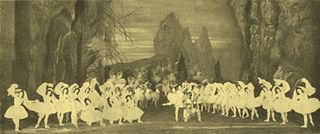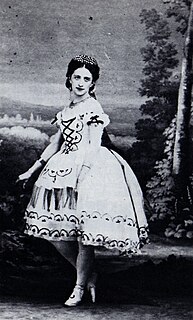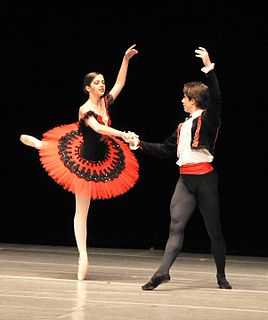
Pierina Legnani was an Italian ballerina considered one of the greatest ballerinas of all time.

Les Ballets Trockadero de Monte Carlo is an all-male drag ballet troupe that parodies the conventions of romantic and classical ballet. In 2008, they performed at the Royal Variety Performance in front of Prince Charles. The company's current artistic director is Tory Dobrin.

La Fille mal gardée is a comic ballet presented in two acts, inspired by Pierre-Antoine Baudouin's 1789 painting, La réprimande/Une jeune fille querellée par sa mère. The ballet was originally choreographed by the Ballet Master Jean Dauberval to a pastiche of music based on fifty-five popular French airs. The ballet was premiered on 1 July 1789 at the Grand Théâtre de Bordeaux in Bordeaux, France under the title Le ballet de la paille, ou Il n'est qu'un pas du mal au bien.

La Bayadère is a ballet, originally staged in four acts and seven tableaux by French choreographer Marius Petipa to the music of Ludwig Minkus. The ballet was staged especially for the benefit performance of the Russian Prima ballerina Ekaterina Vazem, who created the principal role of Nikiya. La Bayadère was first presented by the Imperial Ballet at the Imperial Bolshoi Kamenny Theatre in St. Petersburg, Russia, on 4 February [O.S. 23 January] 1877. From the first performance the ballet was universally hailed by contemporary critics as one of the choreographer Petipa's supreme masterpieces, particularly the scene from the ballet known as The Kingdom of the Shades, which became one of the most celebrated pieces in all of classical ballet. By the turn-of-the 20th century, The Kingdom of the Shades scene was regularly extracted from the full-length work as an independent showpiece, and it has remained so to the present day.

Pas de trois[pɑ də tʁwɑ] is a French term usually referring to a dance in ballet between three people. Typically, a pas de trois in ballet consists of five parts:
- Entrée
- Variation for the 1st dancer
- Variation for the 2nd dancer
- Variation for the 3rd dancer
- Coda
Paquita is a ballet in two acts and three scenes originally choreographed by Joseph Mazilier to music by Édouard Deldevez and Ludwig Minkus.

Fiametta or Fiammetta, is a ballet in four acts and four scenes, choreographed by Arthur Saint-Léon to music by Ludwig Minkus, first presented by the Ballet of the Moscow Imperial Bolshoi Theatre on November 12–24, 1863 at the Moscow Imperial Bolshoi Theatre, Moscow, Russia, with Anna Sobeshchanskaya as Fiametta.

The Sacrifices to Cupid is a "grand ballet" in 1 Act/1 scene with choreography by Marius Petipa and music by Ludwig Minkus.
Roxana, the Beauty of Montenegro is a fantastic ballet in four acts, with choreography by Marius Petipa and music by Ludwig Minkus. Libretto by Sergei Khudekov and Marius Petipa.
The Daughter of the Snows is a fantastic ballet in three acts and five scenes, with choreography by Marius Petipa and music by Ludwig Minkus. The libretto by Marius Petipa is based on the play The Snow Maiden by Alexander Ostrovsky, inspired by a Russian folk fairy tale about Snegurochka from the folklore collection by Alexander Afanasyev.

Le Diable à quatre is a ballet in two acts and three scenes, with choreography by Joseph Mazilier, music by Adolphe Adam, and libretto by Adolphe de Leuven, first presented by the Ballet of the Académie Royale de Musique on 11 August 1845, with Carlotta Grisi and Lucien Petipa.

Raymonda is a ballet in three acts, four scenes with an apotheosis, choreographed by Marius Petipa to music by Alexander Glazunov, his Opus 57. First presented by the Imperial Ballet at the Imperial Mariinsky Theatre on 19 January [O.S. 7 January] 1898 in Saint Petersburg, Russia. The ballet was created especially for the benefit performance of the Italian ballerina Pierina Legnani, who created the title role. Among the ballet's most celebrated passages is the Pas classique hongrois from the third act, which is often performed independently.
The 1917 Petipa/Ivanov/Drigo revival of Swan Lake is a famous version of the ballet Swan Lake,, . This is a ballet by Pyotr Ilyich Tchaikovsky based on an ancient German legend, presented in either four acts, four scenes, three acts, four scenes or, more rarely, in two acts, four scenes. Originally choreographed by Julius Reisinger to the music of Pyotr Ilyich Tchaikovsky, it was first presented as The Lake of the Swans by the Ballet of the Moscow Imperial Bolshoi Theatre on 20 February/4 March 1877 in Moscow, Russia. Although the ballet is presented in many different versions, most ballet companies today base their stagings both choreographically and musically on this revival by Marius Petipa and Lev Ivanov, staged for the Imperial Ballet, first presented on 15 January/27 January 1895, at the Imperial Mariinsky Theatre in St. Petersburg, Russia instead of the original version.

Alexander Gorsky, a Russian ballet choreographer and a contemporary of Marius Petipa, is known for restaging Petipa’s classical ballets such as Swan Lake, Don Quixote, and The Nutcracker. Gorsky “sought greater naturalism, realism, and characterization” in ballet. He valued acting skills over bravura technique His interpretations of ballets were often controversial and he often used artists outside the dance world to create sets and costumes.

Natalia Matsak born on 17 March 1982, Kyiv) is a Ukrainian ballet dancer, prima ballerina in the National Opera House of Ukraine, and an Honored Artist of Ukraine.
Antoine Simon,, was a French composer, director and pianist, who made most of his career in Russia.

Anastasia Stashkevich is a Russian principal dancer with the Bolshoi Ballet.














